How to order noodles
There are a variety of noodle dishes available in Thailand ranging between dry dishes and soup dishes. They are widely available everywhere in the Kingdom. It can be considered the Fast Food of choice for the majority of Thai people. I want to talk about how to order noodle dishes in restaurants or street vendors given the few steps needed in the doing so. 🙂
Noodle soup in Thai is called “Kuai Tiao ก๋วยเตี๋ยว /gŭai-dtĭao/”
Step 1 : knowing what kind of noodle soup dish you want to go for.
Below is the list of most common soup noodle dishes found in Thailand:
1) Kuai Tiao Nam Sai ก๋วยเตี๋ยวน้ำใส / gŭai-dtĭao náam săi/: this is the most basic noodle soup dish. “Nam Sai” (น้ำใส) means ‘clear stock’ usually made from pork, chicken or beef bones, flavored with salt, pepper, garlic, sugar, coriander.
The noodles are prepared with a variety of meats – pork หมู/mŭu/, beef เนื้อ /núea/, duck เป็ด /bpèd/, offal เครื่องใน /krûeang-nai/ , fishballs ลูกชิ้นปลา /lûuk-chín bplaa/, meatballs ลูกชิ้นเนื้อ / lûuk-chín núea/ porkballs ลูกชิ้นหมู / lûuk-chín mŭu/ being the most common, as well as vegetables and bean sprouts and then served with standard.
2) Kuai Tiao Tom Yam ก๋วยเตี๋ยวต้มยำ / gŭai-dtĭao dtôm yam/: it is the same recipe as Kuai Tiao Nam Sai, but added chili paste (น้ำผริกเผา /náam prík păo/), crushed peanuts, lime juice, chili powder, sugar and fish sauce. It is usually sweeter than regular soup and available for pork, fish and seafood.
3) Kuai Tiao Ruea ก๋วยเตี๋ยวเรือ / gŭai-dtĭao ruea/: Oh! This is my favorite noodle soup dish. เรือ /ruea/ means ‘boat’. This type of noodle soup used to be served on boats where in the old times the sellers rowed the boat along the canal to the piers alongside their houses.
The base ingredient is the blood from pigs or cows which is called “Nam Tok” (น้ำตก /náam-dtòk/) which is poured into the soup right before serving giving the soup a distinct taste. Available for pork and pork balls, or beef and meatballs, liver pieces, bean sprouts, morning glory and parsley.
If you don’t feel like eating this vampire-dish, you can order without the blood by saying “ไม่เอาน้ำตก /mâi ao náam-dtòk/ meaning I don’t want the blood.’” However, I recommend you to give it a try, it doesn’t taste bad but soooo good!
4) Yen Ta Fo เย็นตาโฟ /yen data foe/ is a noodle pink soup. Served with different kinds of fish balls, shrimp balls, sliced fried tofu, squid, morning glory aka pak bung ผักบุ้ง /pàk bûng/, and deep-fried dumplings- Giaw ( เกี๊ยว/gíaw/). The pink color comes from the special sauce made from preserved red bean curd and/or tomato ketchup. The dish is mildly sweet, salty and sour.
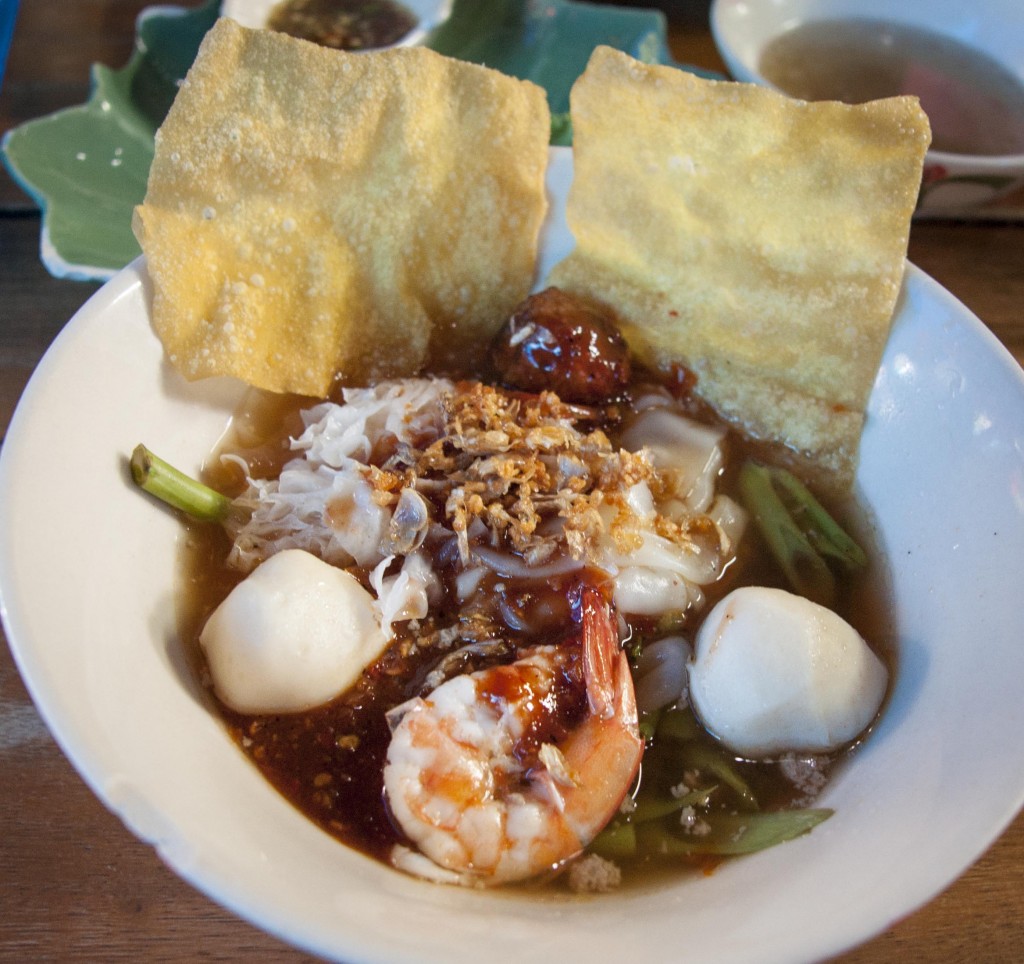
Step 2: choose the types of noodles
Once you know what type of noodle soup you want to have and select the right place to eat, you can decide what kind of noodles you enjoy.
There are five main types of noodles:
- Wide rice noodles “sen Yai” ( เส้นใหญ่ / sên yài/)
- Small rice noodles “sen lek” ( เส้นเล็ก /sên lék/)
- Vermicelli “sen mee” ( เส้นหมี่ /sên mìi/ ): fine round rice noodles
- Yellow egg noodles “sen ba-mee” ( เส้นบะหมี่ / sên bà-mìi/ ): made from wheat flour and egg.
- Glass noodles “wun sen” ( วุ้นเส้น/wún sên/ ): made from mung beans
Whatever type of noodle soup I choose to eat I always order “sen mee”, my younger brother always go for “sen ba-mee”, and my mom always orders “Sen Yai”. It is the matter of personal choice I think:)
NOTE: You can also order noodles without noodles too! Sounds funny right? But you can do all that, it is called Gao Lao เกาเหลา /gao-lăo/. Basically, you have everything in the bowl except the noodles. Thai people commonly order Gao Lao to eat with steamed rice.
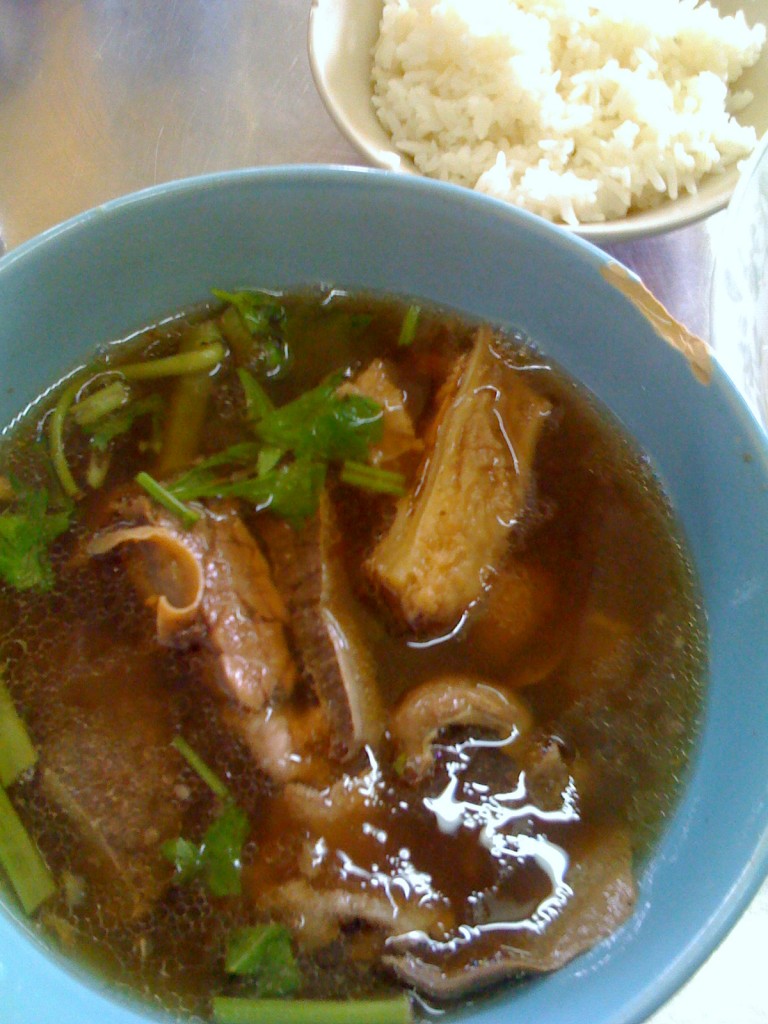
Step 3: with soup or without soup
All above noodle soup dishes can be ordered without the stock. In that case all the ingredients are cooked in the soup first, but served “dry” without the stock or the stock comes separately. This is called kuai-tiao haeng ก๋วยเตี๋ยวแห้ง / gŭai-dtĭao hâeng/ which literally means ‘dry noodles’.
Step 4: Seasoning
Now you got a noodle soup in front of you. Next step is to season your noodle soup to your liking. At the noodles place you will always see a set of different seasoning พวงเครื่องปรุง /puang krûeang-bprung/ available on each table which usually consist of 1) chili powder 2) sugar 3) rice vinegar with chilies 4) fish sauce
I usually add a tea spoon of chili powder and a little bit of fish sauce in my noodle soup.
What kind of noodle soup dish do you like? 🙂
YOU MIGHT ALSO LIKE:
-
VIDEO: Eat like a Thai 101
-
My Top 7 Favourite Thai Restaurants
-
My Top 5 Most Romantic Restaurants in Bangkok
-
My Favourite Riverside Restaurants
-
READ: Street Thai Food : ข้าวราดแกงKhao Raat Gaeng

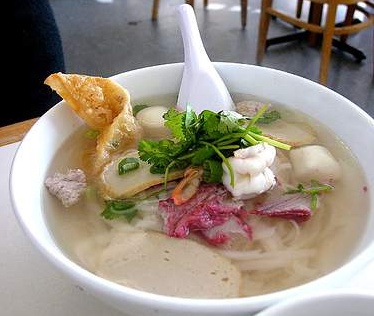
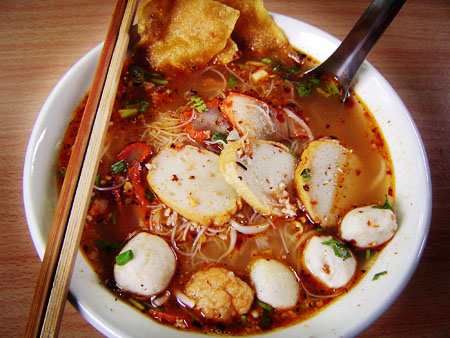
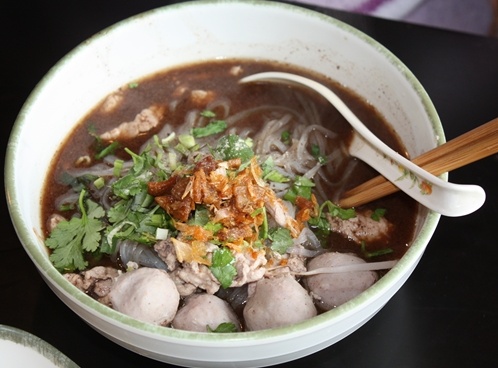
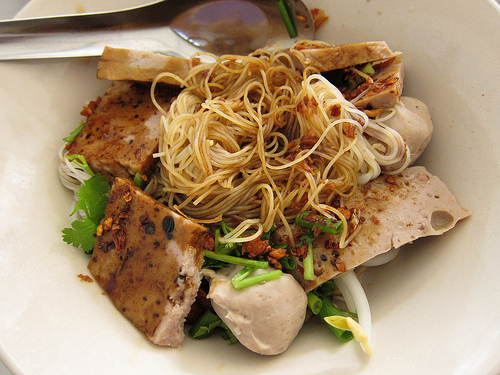
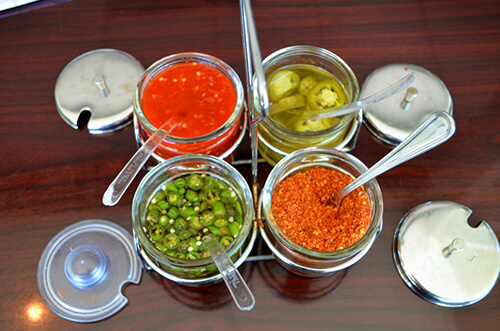
How do you say “no organs” or “no offals” in Thai?
Reading this makes me so so hungry… I miss Thailand 🍲🍜
Hi Mod
Great article about the delicious noodle soup!
The picture was taken in what restaurant ?
If i’m not mistaken, it’s one of your favourite restaurants for kuai tiao rua. It seems to be located somewhere in a shopping mall.
I would very much appreciate it if you let me know the name .
Best regards,
Erwin
Sawatdii ka Erwin, thank you for your comments.
The restaurant in the picture is Nara in EmQuartier shopping mall located next to Phrom Phong BTs station.
What I learned about the four condiments served with soups and noodles is that they represent the “big four” flavors of Thai gastronomy – sweet (sugar), sour (vinegar), savory (fish sauce), spicy (chili powder). I was shown that mixing all four together give a very good flavor, with the sugar mellowing the vinegar, fish sauce, and chili to make a completely unique flavor that tastes nothing like the individual components. The rule of thumb I was taught for a medium-sized serving of soup or noodles was one scoop each of sugar, vinegar, and fish sauce, and chili according to taste (one half to one scoop for my farang palate depending on my mood for spice). It’s been fun for me to experiment with these flavors and be able to add flavor to both clear broth soups and also noodles like pad Thai and pad see ew.
Wow! that is interesting! I have never heard about the ‘big four’ before. Thank you for sharing.
Like the article. I sometimes go to a street vendor where i live that does fish balls, i usually just say ba-mee nam pla. i’m not sure if this is the correct thing to say or not, i usually get a bowl of soup with fish balls, something sliced, some noodles and crispy bits all in a clear broth.
The soup or stock is usually a little bit bland (tasteless) so i add a few flavourings to improve it. Are you saying, i can go to a place like this, order my soup as normal and if i say tom yam, they will spice it up for me with chilli, limes and sugar or do i have to go to a place that specifically sells tom yam noodle soup. Will any vendor do this for you?
The reason i ask is, I didn’t notice any limes the last time i was there but maybe they were just hidden out of sight.
Thank you for your positive comment. 🙂
If you would like to have Tom Yam noodles you have to go to a specific place that cook this type of noodles. Usually a noodle stall serves one or two types of noodles not all.
Good luck 🙂
Great advice, how about a video at a street sellers stall to help with pronunciation as a lot of the street vendors hardly speak any english and it would be nice to be able to ask them in Thai.
Thank you for reading my post. I would love to do videos outside on the street but I am still lack of equipments to cut background noise. I tried filming outside a few times but the noise is a big problem.
Hi, I was wondering if anyone her happens to have a “beef gao lao” recipe, I have been looking for so long, please email me ash.stackz@gmail.com
Thanks Mod
I have moved to Thailand and am struggling to get food other than Kwai Teo Moo. This has been an excellent Lesson to improve my diet.
Hi Mod,
sometimes when I ask at noodle stands if they can make vegetarian noodle soup they say yes, but I worry that the broth is likely to have been made with animal parts. can you tell us how I can specifically ask if the broth is vegetarian?
Thank you!!!!
Sawatdee ka Anne,
One easy way to ask is น้ำซุปทำจากอะไร /naam-soup tam jaak a-rai?/ What is the broth made of?
น้ำซุป /naam soup/ means broth.
Anyway, I don’t think the noodle stands make vegetarian broth. Usually they use pork, chicken or beef bones.
I like the nam dtok with pork, bamee style noodles:)
I really like this post! Maybe you could do a post about Isaan food sometime?:))
Thank you for a wonderful blog!
Hi Khru Mod, this is so interesting! Incidentally, all these noodles are found in Singapore where I live, and they are mainly consumed by the Chinese. Yes, we have all the types of noodles you listed; we have one more which is yellow wheat noodles which I did not see in Thailand. For the wide flat rice noodles, we call it “kway tiao”. Ingredient-wise, everything is similar except that we do not have the “vampire” one. However, we do have pig blood cubes served with offal with salted vegetables in a soup. In local slang, it is also known as “spare parts” soup. People here, especially the younger generation, have moved away from such exotic dishes, even the preserved red bean curd. A local spicy favourite is “laksa” which is rice noodles in a hot and spicy soup with coconut milk and served with fresh cockles and of course “laksa” leaves which are found in Thailand too. You should come here one day.
Thank you for reading my post. I did not try noodles when I was in Singapore. Next time I won’t miss it:)